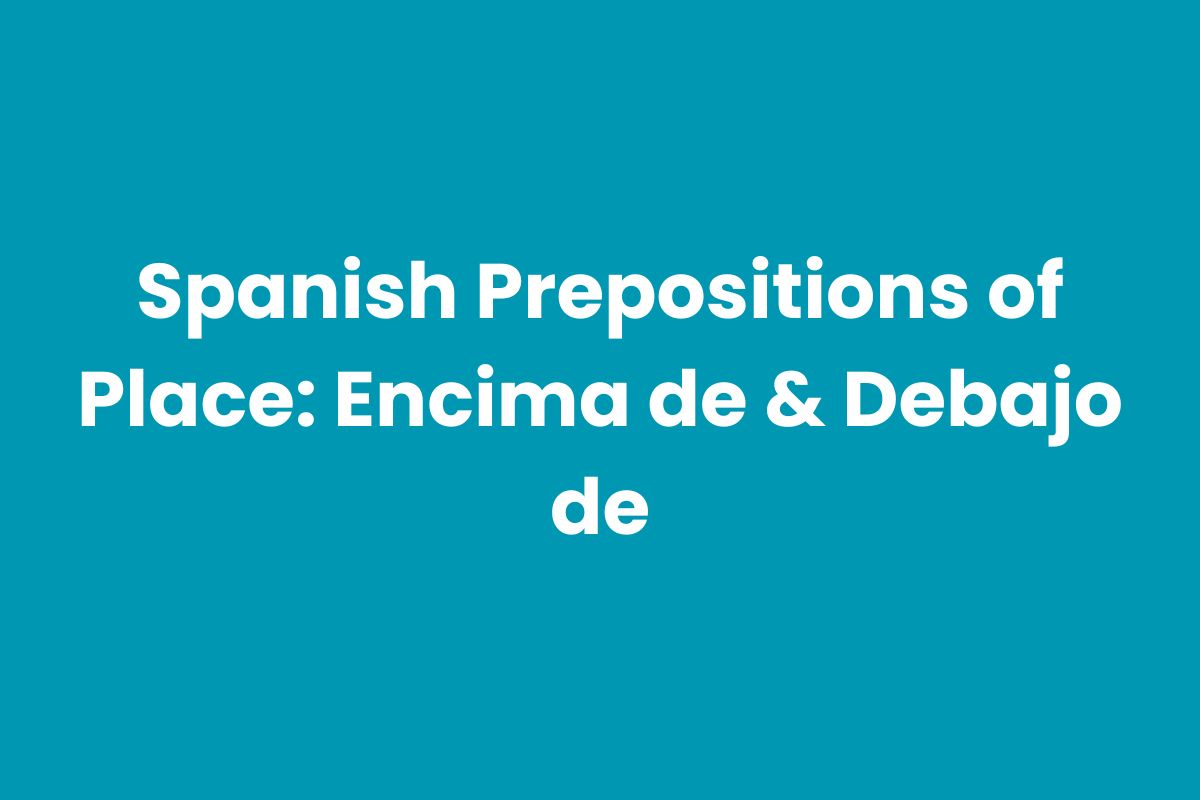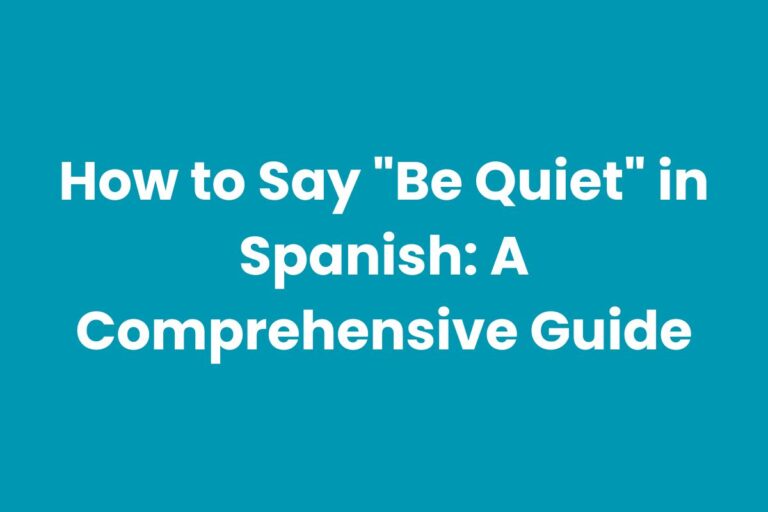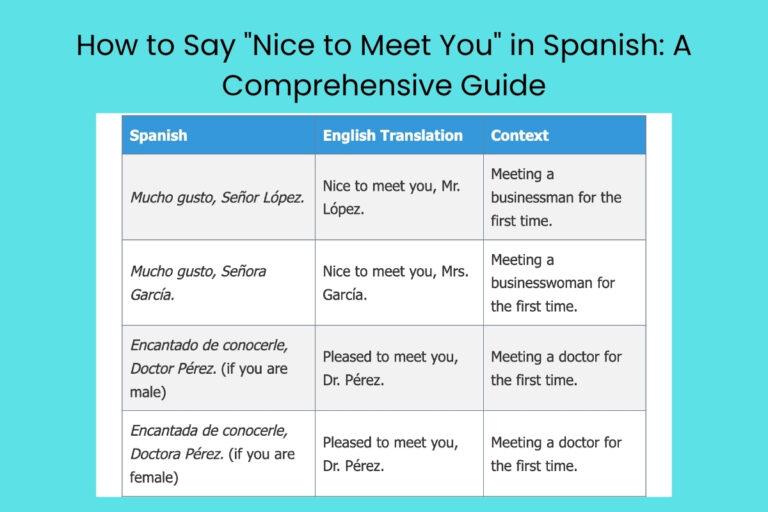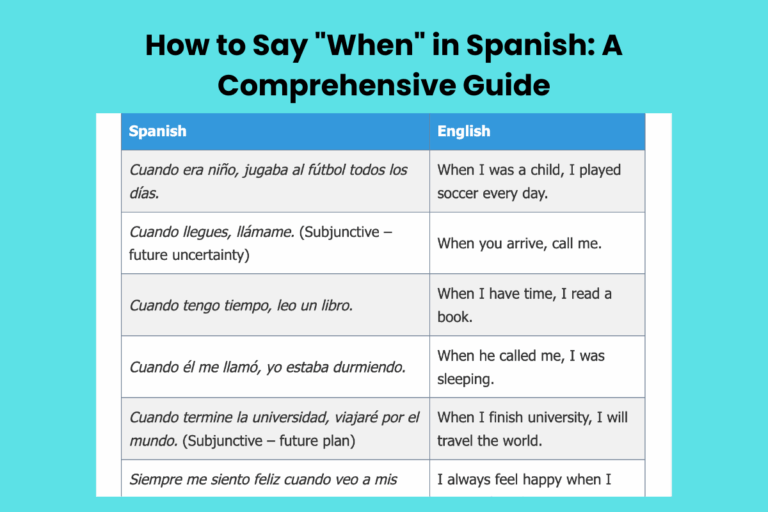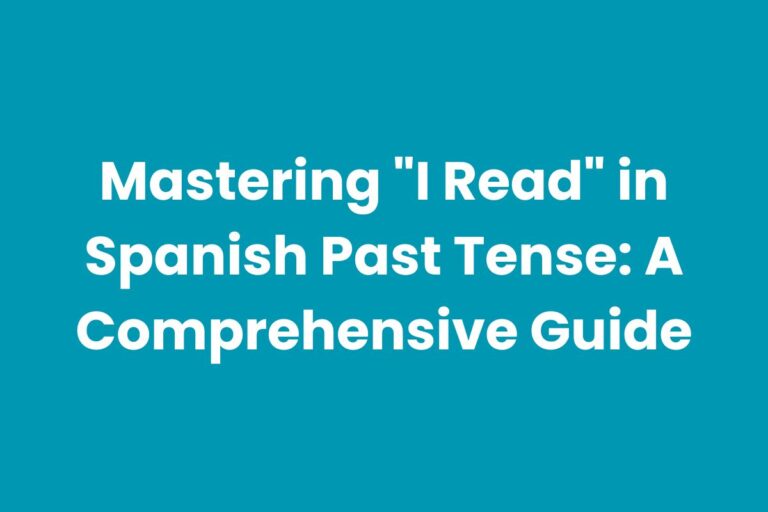Spanish Prepositions of Place: Encima de & Debajo de
Understanding prepositions of place is crucial for describing spatial relationships accurately in any language. In Spanish, prepositions like encima de (on top of) and debajo de (underneath) are fundamental for indicating where things are located relative to each other. Mastering these prepositions not only enhances your descriptive abilities but also improves your overall comprehension of spoken and written Spanish. This article provides a comprehensive guide to encima de and debajo de, suitable for Spanish learners of all levels, from beginners to advanced students. This guide will cover definitions, structural usage, examples, common mistakes, and practice exercises to solidify your understanding.
This article is designed for anyone learning Spanish who wants to improve their understanding of spatial relationships. Whether you are a beginner just starting to learn basic vocabulary or an advanced learner looking to refine your grammar, this guide will provide you with the tools and knowledge you need to use encima de and debajo de correctly and confidently.
Table of Contents
- Definition of Encima de and Debajo de
- Structural Breakdown
- Types and Categories
- Examples of Encima de and Debajo de
- Usage Rules
- Common Mistakes
- Practice Exercises
- Advanced Topics
- FAQ
- Conclusion
Definition of Encima de and Debajo de
In Spanish, prepositions of place indicate the spatial relationship between two or more entities. Encima de and debajo de are two fundamental prepositions that describe vertical positioning. Understanding these prepositions is essential for accurately describing locations and relationships between objects, people, and even abstract concepts.
Encima de
Encima de literally translates to “on top of” or “above.” It indicates that one object is positioned directly over another, with the implication of physical contact or close proximity. This preposition is used to describe a situation where one thing is resting or situated on the surface of something else.
Debajo de
Debajo de translates to “underneath” or “below.” It signifies that one object is located directly beneath another, typically implying that the higher object is covering or sheltering the lower one. Like encima de, it usually implies physical contact, though this is not always the case. The key is that one object is vertically below the other.
Structural Breakdown
The basic structure for using encima de and debajo de in a sentence is relatively straightforward. It generally follows the pattern:
Noun/Pronoun + Verb (usually estar or ser) + Encima de / Debajo de + Noun/Pronoun
Here’s a breakdown:
- Noun/Pronoun (Subject): The object or person whose location is being described.
- Verb: Typically a form of estar (to be – for temporary states and locations) or ser (to be – for permanent characteristics). Estar is more common when describing location.
- Encima de / Debajo de: The preposition indicating the spatial relationship.
- Noun/Pronoun (Object): The reference point to which the subject’s location is being compared.
For example:
- El libro está encima de la mesa. (The book is on top of the table.)
- El gato está debajo de la cama. (The cat is underneath the bed.)
In these examples, el libro and el gato are the subjects, está is the verb (a form of estar), and la mesa and la cama are the objects serving as reference points.
Types and Categories
While the core meaning of encima de and debajo de remains consistent, their usage can vary slightly depending on the context. Here are some categories to consider:
Physical Objects
This is the most common usage, referring to the literal positioning of objects in relation to each other. For example, “The pen is on top of the notebook” (El bolígrafo está encima del cuaderno) or “The rug is underneath the table” (La alfombra está debajo de la mesa).
People and Animals
These prepositions can also describe the position of people or animals in relation to other objects or locations. For example, “The child is on top of the slide” (El niño está encima del tobogán) or “The dog is underneath the chair” (El perro está debajo de la silla).
Abstract Concepts (Less Common)
Although less frequent, encima de and debajo de can sometimes be used metaphorically to describe abstract relationships. For example, “He is on top of the situation” (Él está encima de la situación) could mean he is in control of it. However, this usage is more common with other prepositions like sobre or expressions like tener el control de. Using debajo de in an abstract sense is even rarer.
Examples of Encima de and Debajo de
To solidify your understanding, let’s explore various examples of encima de and debajo de in different contexts. The following sections provide examples related to objects, people, and abstract concepts.
Objects
This table illustrates the use of encima de and debajo de to describe the relative positions of physical objects. The examples are designed to showcase how these prepositions are used in everyday scenarios.
| Spanish Sentence | English Translation |
|---|---|
| El vaso está encima de la mesa. | The glass is on top of the table. |
| La alfombra está debajo de la cama. | The rug is underneath the bed. |
| El libro está encima de la silla. | The book is on top of the chair. |
| Los zapatos están debajo de la cama. | The shoes are underneath the bed. |
| La lámpara está encima del escritorio. | The lamp is on top of the desk. |
| El cargador está debajo del sofá. | The charger is underneath the sofa. |
| La computadora está encima de la caja. | The computer is on top of the box. |
| Las llaves están debajo de la almohada. | The keys are underneath the pillow. |
| El cuadro está encima de la chimenea. | The painting is on top of the fireplace. |
| El control remoto está debajo de la revista. | The remote control is underneath the magazine. |
| El plato está encima del mantel. | The plate is on top of the tablecloth. |
| La basura está debajo del fregadero. | The trash is underneath the sink. |
| La maceta está encima del estante. | The flowerpot is on top of the shelf. |
| El polvo está debajo del mueble. | The dust is underneath the furniture. |
| El sombrero está encima del perchero. | The hat is on top of the coat rack. |
| El tapete está debajo de la puerta. | The doormat is underneath the door. |
| El jarrón está encima del piano. | The vase is on top of the piano. |
| El cable está debajo del escritorio. | The cable is underneath the desk. |
| La toalla está encima del radiador. | The towel is on top of the radiator. |
| El periódico está debajo de la silla. | The newspaper is underneath the chair. |
| La tetera está encima de la estufa. | The kettle is on top of the stove. |
| El hielo está debajo de la mesa. | The ice is underneath the table. |
| La fruta está encima del mostrador. | The fruit is on top of the counter. |
| La caja está debajo de la escalera. | The box is underneath the staircase. |
| La almohada está encima de la cama. | The pillow is on top of the bed. |
| El ratón está debajo del teclado. | The mouse is underneath the keyboard. |
People
This table focuses on examples where encima de and debajo de describe the position of people in relation to objects or locations. These examples help illustrate how to use these prepositions with human subjects.
| Spanish Sentence | English Translation |
|---|---|
| El niño está encima del caballo. | The boy is on top of the horse. |
| El bebé está debajo de la manta. | The baby is underneath the blanket. |
| La niña está encima del columpio. | The girl is on top of the swing. |
| El mecánico está debajo del coche. | The mechanic is underneath the car. |
| El alpinista está encima de la montaña. | The climber is on top of the mountain. |
| El gato está debajo de la mesa. | The cat is underneath the table. |
| El perro está encima de la cama. | The dog is on top of the bed. |
| El loro está encima de la jaula. | The parrot is on top of the cage. |
| El buceador está debajo del agua. | The diver is underneath the water. |
| El acróbata está encima de la cuerda. | The acrobat is on top of the rope. |
| El gato está debajo del árbol. | The cat is underneath the tree. |
| El niño está encima del sofá. | The boy is on top of the sofa. |
| El conejo está debajo del arbusto. | The rabbit is underneath the bush. |
| La bailarina está encima del escenario. | The dancer is on top of the stage. |
| El caracol está debajo de la hoja. | The snail is underneath the leaf. |
| El pájaro está encima del tejado. | The bird is on top of the roof. |
| El hámster está debajo de la rueda. | The hamster is underneath the wheel. |
| El payaso está encima del monociclo. | The clown is on top of the unicycle. |
| El topo está debajo de la tierra. | The mole is underneath the ground. |
| El piloto está encima del avión. | The pilot is on top of the plane. |
| El zorro está debajo del granero. | The fox is underneath the barn. |
| El atleta está encima del podio. | The athlete is on top of the podium. |
| El gusano está debajo de la manzana. | The worm is underneath the apple. |
| La reina está encima del trono. | The queen is on top of the throne. |
| El pez está debajo del barco. | The fish is underneath the boat. |
Abstract Concepts
This table presents examples of encima de and debajo de used in a more abstract or figurative sense. While less common, these examples demonstrate the versatility of these prepositions in Spanish.
| Spanish Sentence | English Translation |
|---|---|
| Él está encima de la situación. (Less common, consider tiene el control de) | He is on top of the situation. (He is in control of the situation.) |
| Siento que estoy debajo de mucho estrés. (More common: Siento mucho estrés) | I feel like I am underneath a lot of stress. (I feel a lot of stress.) |
| Ella está encima de sus estudios. (Less common, consider dedicada a) | She is on top of her studies. (She is dedicated to her studies.) |
| Me siento debajo de la presión. (More common: Siento la presión) | I feel underneath the pressure. (I feel the pressure.) |
| Está encima de todos los detalles. (Less common, consider atento a) | He is on top of all the details. (He is attentive to all the details.) |
| Se siente debajo de una nube negra. (Figurative) | He feels under a dark cloud. |
| Ella está encima del proyecto. (Less common, consider a cargo del proyecto) | She is on top of the project. (She is in charge of the project.) |
| Se siente debajo de la bota. (Figurative) | He feels under the boot. (Oppressed) |
| Él está encima de las cosas. (Less common, consider organizado) | He is on top of things. (He is organized.) |
| Ella se siente debajo de la sociedad. (Figurative) | She feels under society. (Oppressed by society.) |
| Está encima de las últimas noticias. (Less common, consider al tanto de) | He is on top of the latest news. (He is aware of the latest news.) |
| Se siente debajo del peso del mundo. (Figurative) | He feels under the weight of the world. |
| Ella está encima del problema. (Less common, consider resolviendo el problema) | She is on top of the problem. (She is solving the problem.) |
| Se siente debajo de la sombra de su hermano. (Figurative) | He feels under the shadow of his brother. |
| Él está encima de la competencia. (Less common, consider superando la competencia) | He is on top of the competition. (He is surpassing the competition.) |
| Se siente debajo del escrutinio público. (Figurative) | He feels under public scrutiny. |
Usage Rules
While the basic structure is simple, there are nuances to using encima de and debajo de correctly. Here are some key rules to keep in mind:
- Agreement: Remember that while encima de and debajo de themselves don’t change, the articles (el, la, los, las) that precede the noun must agree in gender and number with the noun. For example, encima de la mesa (feminine singular) vs. debajo de los libros (masculine plural).
- Contractions: When de is followed by el, it contracts to del. However, this contraction is not used with encima de or debajo de. You would say encima de el armario, but it’s much more common to simply say en el armario (inside the closet). With encima or debajo, you would say encima de el armario (on top of the closet) or debajo de el armario (underneath the closet). The use of the article in these cases is optional and often omitted.
- Verb Choice: As mentioned earlier, estar is generally used with encima de and debajo de to indicate location. Ser is used to describe inherent qualities or permanent characteristics, and is less common with these prepositions.
- Omission of ‘de’: In some cases, especially in informal speech or writing, the ‘de’ can be omitted. For instance, you might hear “El libro está encima la mesa,” although “El libro está encima de la mesa” is grammatically more correct. However, omitting ‘de’ is not recommended in formal contexts.
Common Mistakes
Learners often make predictable errors when using encima de and debajo de. Here are some common mistakes and how to avoid them:
| Incorrect | Correct | Explanation |
|---|---|---|
| El libro está encima la mesa. | El libro está encima de la mesa. | Missing the preposition ‘de’. |
| El gato está debajo la silla. | El gato está debajo de la silla. | Missing the preposition ‘de’. |
| Encima del mesa está el vaso. | Encima de la mesa está el vaso. | Incorrect article agreement. |
| Debajo del cama está el perro. | Debajo de la cama está el perro. | Incorrect article agreement. |
| El libro es encima de la mesa. | El libro está encima de la mesa. | Using ser instead of estar to indicate location. |
| El gato ser debajo de la cama. | El gato está debajo de la cama. | Using ser instead of estar to indicate location. |
| Encima de el libro está el lápiz. | Encima del libro está el lápiz. (Less Common) OR En el libro está el lápiz | While grammatically correct, in this context, it would be more common to use “en.” |
| Debajo de el árbol está el perro. | Debajo del árbol está el perro. (Less Common) OR En el árbol está el perro | While grammatically correct, in this context, it would be more common to use “en.” |
Practice Exercises
Test your understanding of encima de and debajo de with these exercises. Each exercise focuses on different aspects of using these prepositions correctly.
Exercise 1: Fill in the Blanks
Complete the following sentences with either encima de or debajo de.
| Question | Answer |
|---|---|
| 1. El plato está _______ la mesa. | encima de |
| 2. El gato está _______ la cama. | debajo de |
| 3. La lámpara está _______ el escritorio. | encima de |
| 4. Los zapatos están _______ el armario. | debajo de |
| 5. El cuadro está _______ la chimenea. | encima de |
| 6. El ratón está _______ la silla. | debajo de |
| 7. La flor está _______ la ventana. | encima de |
| 8. El perro está _______ la mesa. | debajo de |
| 9. El vaso está _______ el libro. | encima de |
| 10. La alfombra está _______ la mesa. | debajo de |
Exercise 2: Translate the Sentences
Translate the following English sentences into Spanish using encima de or debajo de.
| English Sentence | Spanish Translation |
|---|---|
| 1. The pen is on top of the paper. | El bolígrafo está encima del papel. |
| 2. The ball is underneath the table. | La pelota está debajo de la mesa. |
| 3. The keys are on top of the dresser. | Las llaves están encima del tocador. |
| 4. The cat is underneath the car. | El gato está debajo del coche. |
| 5. The bird is on top of the roof. | El pájaro está encima del tejado. |
| 6. My feet are under the blanket. | Mis pies están debajo de la manta. |
| 7. The clock is on the wall above the sofa. | El reloj está encima de la pared sobre el sofá. |
| 8. The dog sleeps under the bed. | El perro duerme debajo de la cama. |
| 9. The plate is on the table. | El plato está encima de la mesa. |
| 10. The dirt is under my fingernails. | La suciedad está debajo de mis uñas. |
Exercise 3: Multiple Choice
Choose the correct preposition to complete the sentence.
| Question | Options | Answer |
|---|---|---|
| 1. El libro está ____ la mesa. | a) encima de b) debajo de c) en | a) encima de |
| 2. El gato está ____ la silla. | a) encima de b) debajo de c) a | b) debajo de |
| 3. La lámpara está ____ el escritorio. | a) debajo de b) encima de c) por | b) encima de |
| 4. Los zapatos están ____ la cama. | a) encima de b) debajo de c) entre | b) debajo de |
| 5. El cuadro está ____ la pared. | a) debajo de b) encima de c) en | b) encima de |
| 6. El perro está ____ la mesa. | a) debajo de b) encima de c) por | a) debajo de |
| 7. La flor está ____ la ventana. | a) debajo de b) encima de c) hacia | b) encima de |
| 8. El niño está ____ el columpio. | a) debajo de b) encima de c) con | b) encima de |
| 9. El agua está ____ el barco. | a) debajo de b) encima de c) contra | a) debajo de |
| 10. La almohada está ____ la cama. | a) debajo de b) encima de c) sin | b) encima de |
Advanced Topics
For advanced learners, it’s beneficial to understand how encima de and debajo de relate to other prepositions of place and how they can be used in more complex sentence structures. For example, consider the difference between encima de and sobre. While both can translate to “on top of,” sobre often implies a more general location or a topic of discussion, while encima de indicates direct physical contact. Similarly, debajo de can be compared with bajo, where bajo is more commonly used in abstract contexts like “under pressure” (bajo presión).
Another advanced concept is the use of these prepositions in compound sentences or with relative clauses. For example: “The book that is on top of the table is mine” (El libro que está encima de la mesa es mío). These constructions require a solid understanding of sentence structure and verb conjugation.
FAQ
Here are some frequently asked questions about using encima de and debajo de:
- What is the difference between encima de and sobre?
While both can mean “on top of,” encima de usually implies direct physical contact, whereas sobre can be more general or refer to a topic. For example, “The book is on top of the table” (physical contact) would be El libro está encima de la mesa, but “The book is about the war” (topic) would be El libro es sobre la guerra.
- When should I use estar vs. ser with these prepositions?
Use estar (to be – temporary state) to indicate location. Use ser (to be – permanent characteristic) to describe inherent qualities. Since encima de and debajo de typically describe location, estar is almost always the correct choice.
- Can I omit the ‘de’ in encima de and debajo de?
In informal speech, sometimes, but it is grammatically incorrect and not recommended in formal writing or situations.
- How do I make sure the article agrees with the noun?
Remember that articles (el, la, los, las) must agree in gender and number with the noun they modify. If the noun is feminine singular, use la; if it’s masculine singular, use el; if it’s feminine plural, use las; and if it’s masculine plural, use los.
- Are there any regional variations in the usage of these prepositions?
While the core meaning remains the same, some regions might prefer certain synonyms or alternative expressions. However, encima de and debajo de are widely understood across the Spanish-speaking world.
- Can encima de and debajo de be used in figurative language?
Yes, but it is less common. Encima de can be used to mean “in control of,” but it’s more common to use other expressions. Debajo de is rarely used in a figurative sense.
- Is it correct to say “arriba de” instead of “encima de“?
Arriba de is also correct and means “above” or “on top of,” but encima de usually implies direct contact. They can often be used interchangeably, but encima de is generally more precise when indicating physical contact.
- What are some common synonyms for debajo de?
Some synonyms for debajo de include bajo and inferior a. However, bajo is often used in more abstract contexts, and inferior a means “inferior to” or “lower than,” which is not always interchangeable.
- How can I improve my understanding of prepositions in general?
Practice, exposure to the language, and focused study are key. Pay attention to how native speakers use prepositions in different contexts, and don’t be afraid to ask questions when you’re unsure.
- Are there any common phrases or idioms that use encima de or debajo de?
While not as common as with other prepositions, you might encounter phrases like “estar encima de algo” (to be on top of something, meaning to be aware of it or in control of it), though other expressions are more prevalent.
Conclusion
Mastering Spanish prepositions of place, particularly encima de and debajo de, is vital for expressing spatial relationships accurately and effectively. This article has provided a comprehensive overview of these prepositions, covering their definitions, structural usage, examples in various contexts, common mistakes to avoid, and practice exercises to solidify your understanding. By diligently studying and practicing the concepts presented here, you can significantly enhance your ability to describe locations and relationships in Spanish.
Remember that consistent practice and exposure to the language are key to mastering any grammar concept. Don’t hesitate to seek out additional resources, such as Spanish-language books, movies, and conversations with native speakers, to further refine your skills. Keep practicing, and you’ll soon be using encima de and debajo de with confidence and accuracy.

